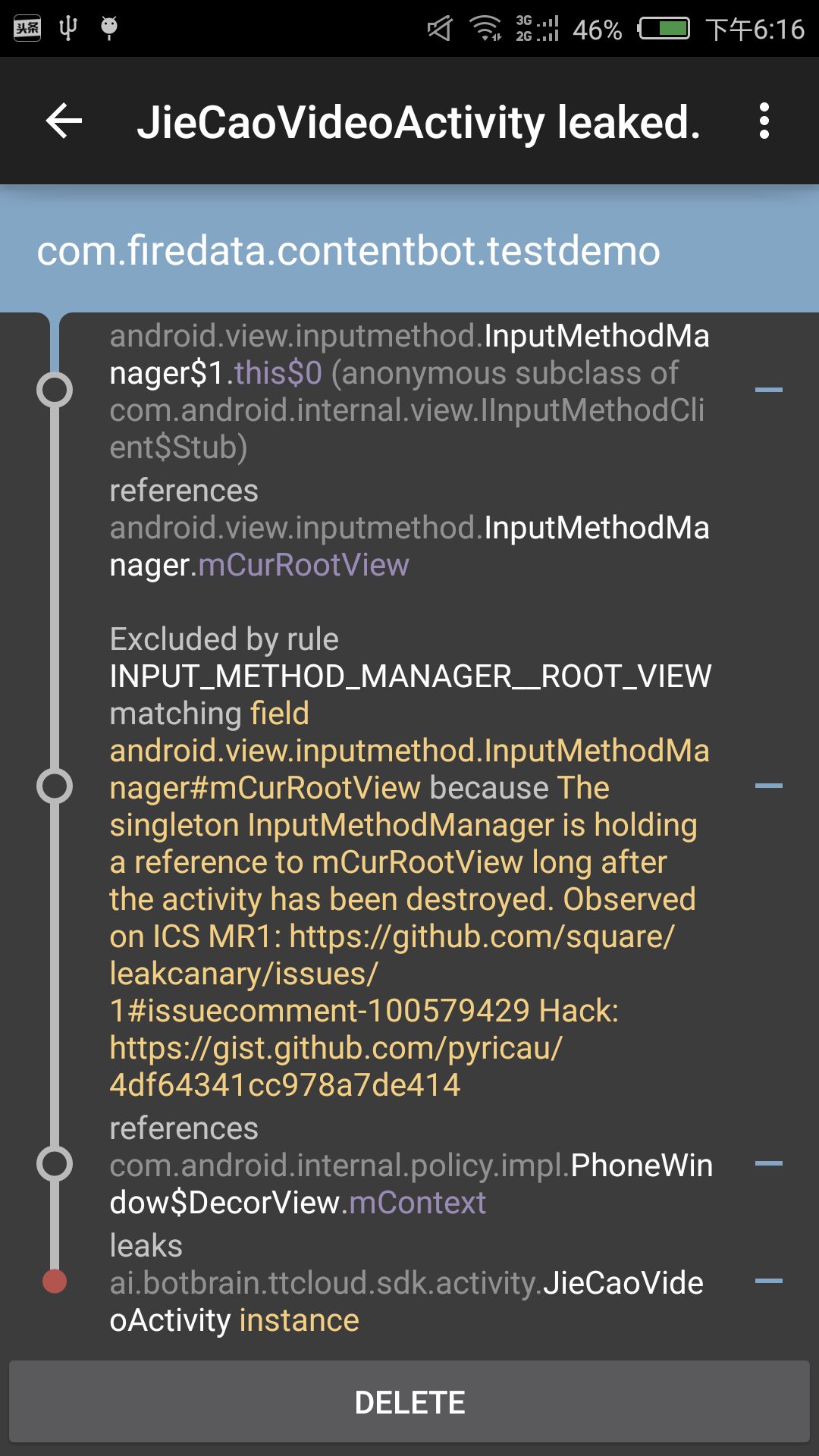LeakCanary检查应用的内存泄露时,报的错误如下图:

内存泄露.png|left|150*400
这是一个Android输入法的一个bug,在15<=API<=23中都存在。
package ai.botbrain.ttcloud.sdk.util;
import android.annotation.TargetApi;
import android.app.Activity;
import android.app.Application;
import android.content.Context;
import android.content.ContextWrapper;
import android.os.Build;
import android.os.Bundle;
import android.os.Looper;
import android.os.MessageQueue;
import android.util.Log;
import android.view.View;
import android.view.ViewTreeObserver;
import android.view.inputmethod.InputMethodManager;
import java.lang.reflect.Field;
import java.lang.reflect.InvocationTargetException;
import java.lang.reflect.Method;
/**
* Description:
* Creator: Created by peter.
* Date: 17/4/24.
*/
public class InputMethodMemoryUtil {
/**
* Fix for https://code.google.com/p/android/issues/detail?id=171190 .
* <p>
* When a view that has focus gets detached, we wait for the main thread to be idle and then
* check if the InputMethodManager is leaking a view. If yes, we tell it that the decor view got
* focus, which is what happens if you press home and come back from recent apps. This replaces
* the reference to the detached view with a reference to the decor view.
* <p>
* Should be called from {@link Activity#onCreate(android.os.Bundle)} )}.
*/
@TargetApi(Build.VERSION_CODES.KITKAT)
public static void fixFocusedViewLeak(Application application) {
// Don't know about other versions yet.
if (Build.VERSION.SDK_INT < Build.VERSION_CODES.ICE_CREAM_SANDWICH_MR1 || Build.VERSION.SDK_INT > 23) {
return;
}
final InputMethodManager inputMethodManager =
(InputMethodManager) application.getSystemService(Context.INPUT_METHOD_SERVICE);
final Field mServedViewField;
final Field mHField;
final Method finishInputLockedMethod;
final Method focusInMethod;
try {
mServedViewField = InputMethodManager.class.getDeclaredField("mServedView");
mServedViewField.setAccessible(true);
mHField = InputMethodManager.class.getDeclaredField("mServedView");
mHField.setAccessible(true);
finishInputLockedMethod = InputMethodManager.class.getDeclaredMethod("finishInputLocked");
finishInputLockedMethod.setAccessible(true);
focusInMethod = InputMethodManager.class.getDeclaredMethod("focusIn", View.class);
focusInMethod.setAccessible(true);
} catch (NoSuchMethodException | NoSuchFieldException unexpected) {
Log.e("IMMLeaks", "Unexpected reflection exception", unexpected);
return;
}
application.registerActivityLifecycleCallbacks(new Application.ActivityLifecycleCallbacks() {
@Override
public void onActivityDestroyed(Activity activity) {
}
@Override
public void onActivityStarted(Activity activity) {
}
@Override
public void onActivityResumed(Activity activity) {
}
@Override
public void onActivityPaused(Activity activity) {
}
@Override
public void onActivityStopped(Activity activity) {
}
@Override
public void onActivitySaveInstanceState(Activity activity, Bundle bundle) {
}
@Override
public void onActivityCreated(Activity activity, Bundle savedInstanceState) {
ReferenceCleaner cleaner = new ReferenceCleaner(inputMethodManager, mHField, mServedViewField,
finishInputLockedMethod);
View rootView = activity.getWindow().getDecorView().getRootView();
ViewTreeObserver viewTreeObserver = rootView.getViewTreeObserver();
viewTreeObserver.addOnGlobalFocusChangeListener(cleaner);
}
});
}
static class ReferenceCleaner
implements MessageQueue.IdleHandler, View.OnAttachStateChangeListener,
ViewTreeObserver.OnGlobalFocusChangeListener {
private final InputMethodManager inputMethodManager;
private final Field mHField;
private final Field mServedViewField;
private final Method finishInputLockedMethod;
ReferenceCleaner(InputMethodManager inputMethodManager, Field mHField, Field mServedViewField,
Method finishInputLockedMethod) {
this.inputMethodManager = inputMethodManager;
this.mHField = mHField;
this.mServedViewField = mServedViewField;
this.finishInputLockedMethod = finishInputLockedMethod;
}
@Override
public void onGlobalFocusChanged(View oldFocus, View newFocus) {
if (newFocus == null) {
return;
}
if (oldFocus != null) {
oldFocus.removeOnAttachStateChangeListener(this);
}
Looper.myQueue().removeIdleHandler(this);
newFocus.addOnAttachStateChangeListener(this);
}
@Override
public void onViewAttachedToWindow(View v) {
}
@Override
public void onViewDetachedFromWindow(View v) {
v.removeOnAttachStateChangeListener(this);
Looper.myQueue().removeIdleHandler(this);
Looper.myQueue().addIdleHandler(this);
}
@Override
public boolean queueIdle() {
clearInputMethodManagerLeak();
return false;
}
@TargetApi(Build.VERSION_CODES.KITKAT)
private void clearInputMethodManagerLeak() {
try {
Object lock = mHField.get(inputMethodManager);
// This is highly dependent on the InputMethodManager implementation.
synchronized (lock) {
View servedView = (View) mServedViewField.get(inputMethodManager);
if (servedView != null) {
boolean servedViewAttached = servedView.getWindowVisibility() != View.GONE;
if (servedViewAttached) {
// The view held by the IMM was replaced without a global focus change. Let's make
// sure we get notified when that view detaches.
// Avoid double registration.
servedView.removeOnAttachStateChangeListener(this);
servedView.addOnAttachStateChangeListener(this);
} else {
// servedView is not attached. InputMethodManager is being stupid!
Activity activity = extractActivity(servedView.getContext());
if (activity == null || activity.getWindow() == null) {
// Unlikely case. Let's finish the input anyways.
finishInputLockedMethod.invoke(inputMethodManager);
} else {
View decorView = activity.getWindow().peekDecorView();
boolean windowAttached = decorView.getWindowVisibility() != View.GONE;
if (!windowAttached) {
finishInputLockedMethod.invoke(inputMethodManager);
} else {
decorView.requestFocusFromTouch();
}
}
}
}
}
} catch (IllegalAccessException | InvocationTargetException unexpected) {
Log.e("IMMLeaks", "Unexpected reflection exception", unexpected);
}
}
private Activity extractActivity(Context context) {
while (true) {
if (context instanceof Application) {
return null;
} else if (context instanceof Activity) {
return (Activity) context;
} else if (context instanceof ContextWrapper) {
Context baseContext = ((ContextWrapper) context).getBaseContext();
// Prevent Stack Overflow.
if (baseContext == context) {
return null;
}
context = baseContext;
} else {
return null;
}
}
}
}
}
用法
@Override
protected void onDestroy() {
super.onDestroy();
InputMethodMemoryUtil.fixFocusedViewLeak(getApplication());
}